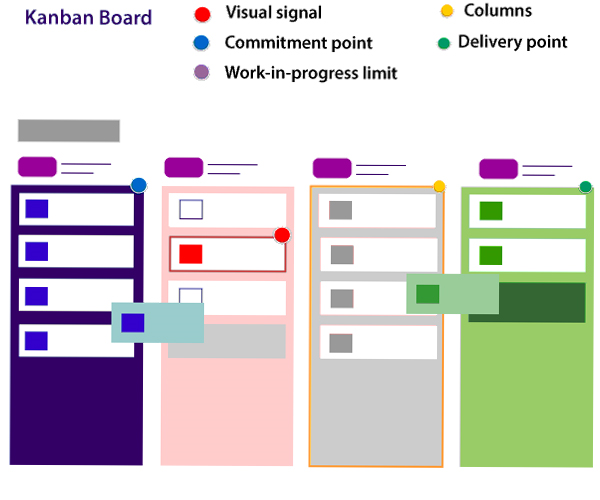Kanban is a popular framework which is used to implement agile software development. It takes real time communication of capacity and complete transparency of work. The work items are represented in a kanban board visually, allowing team members to see the state of every piece of work at any time.
Boards
The kanban board is the agile project management tool that designed the necessary visualized work, limited work-in-progress, and maximizes flow (or efficiency). It uses cards, columns, and provides continuous improvement to help technology and service teams who commit the right amount of work and get it done.
Elements of a kanban board
A person called David Anderson divides the kanban board into five different components. These are Visual signals, columns, work-in-progress limits, a commitment point, and a delivery point.

- Visual Signals: The kanban board is a visual card (stickies, tickets, or otherwise). Kanban team write their projects and work items onto cards, usually per person each card. For agile teams, each card could encapsulate into one user story. Once the board completed, this visual team helps team members and stock members quickly to understand what the team is working.
- Columns: The column represents the specific activities that compose a "workflow" together. The card flows through a workflow until its completion. The workflow may be a simple as "To Do," "In Progress," "Complete," or much more complicated.
- Work in progress (WIP) Limits: The work in progress limits are the maximum number of cards which can be in one column. This is at any given time. It gives the alert signal that you committed too much work.
- Commitment point: Kanban teams also maintain a backlog for their board. This is where the customers and team member put ideas for projects that the team can pick up. The team members pick up plans when they are ready. The committed point is a movement where the design is picked up by the team, and work starts on the project.
- Delivery point: It is the end point of a kanban team's workflow. Mostly the delivery point for every team is when the product and services are handed to the customer.
Kanban vs Scrum board
The following are the
differences between Kanban and Scrum board:
|
Kanban |
Scrum |
|
Kanban is
an ongoing process. |
Scrum
sprints have a start and stop dates |
|
Kanban
has no formal roles. |
Role is
clearly defined of each team in the scrum (product owner, development team,
and scrum master). Both teams are self-organized. |
|
A kanban
board is used throughout the lifecycle of a project |
Scrum
board is cleared and recycled after each sprint. |
|
This
board is more flexible with regards to tasks and timing. Its task can be
reprioritized, reassigned, or updated as needed. |
This board
has the number of tasks and a strict deadline to complete them. |
Kanban
Kanban is the combined methodology for implementing agile
software development. Like scrumban, it is a combination of both scrum and
kanban (mixed) methodology.



0 Comments